engine coolant MAZDA MODEL 3 HATCHBACK 2005 Owner's Manual (in English)
[x] Cancel search | Manufacturer: MAZDA, Model Year: 2005, Model line: MODEL 3 HATCHBACK, Model: MAZDA MODEL 3 HATCHBACK 2005Pages: 322, PDF Size: 4.7 MB
Page 104 of 322
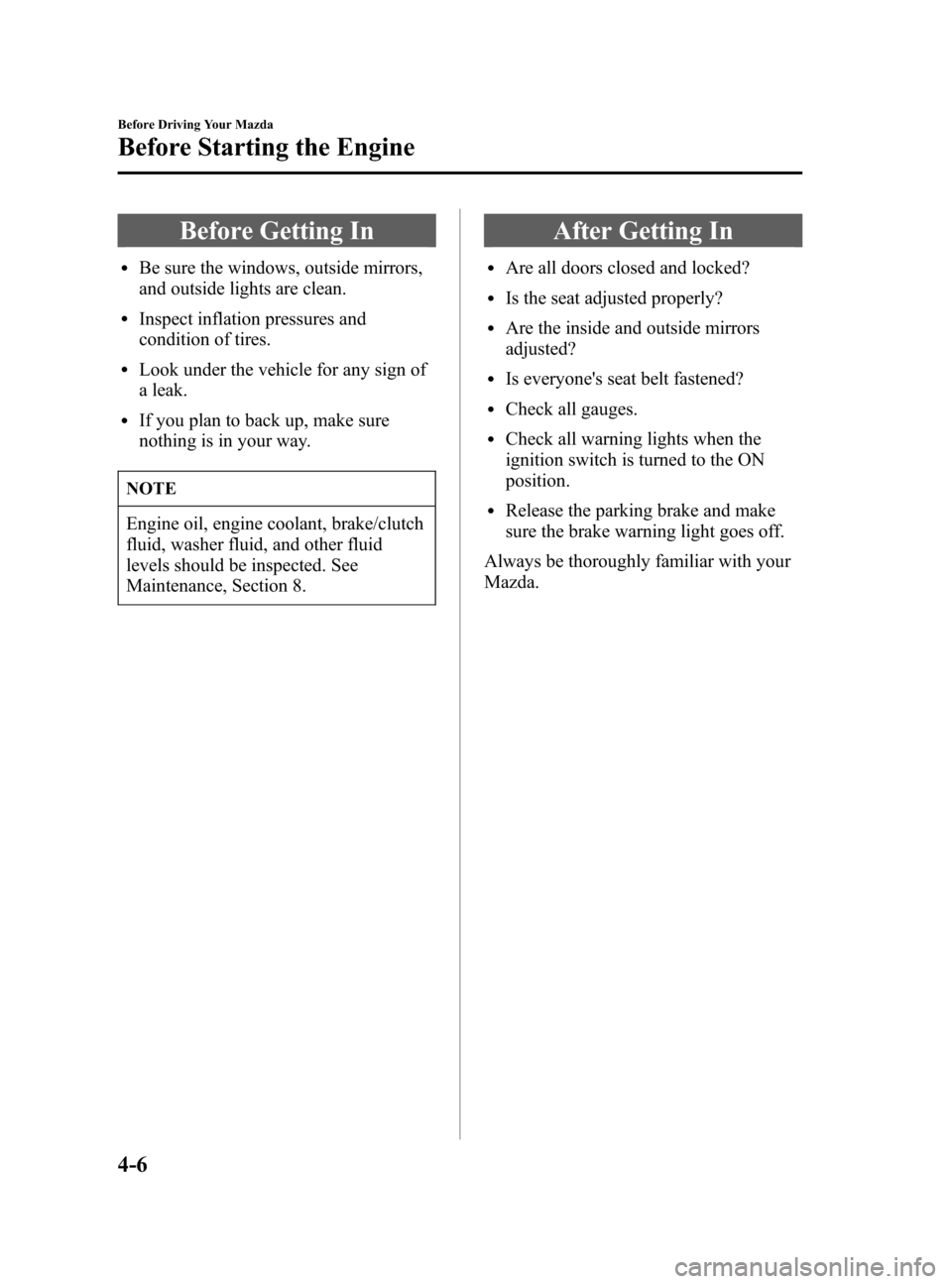
Black plate (104,1)
Before Getting In
lBe sure the windows, outside mirrors,
and outside lights are clean.
lInspect inflation pressures and
condition of tires.
lLook under the vehicle for any sign of
a leak.
lIf you plan to back up, make sure
nothing is in your way.
NOTE
Engine oil, engine coolant, brake/clutch
fluid, washer fluid, and other fluid
levels should be inspected. See
Maintenance, Section 8.
After Getting In
lAre all doors closed and locked?
lIs the seat adjusted properly?
lAre the inside and outside mirrors
adjusted?
lIs everyone's seat belt fastened?
lCheck all gauges.
lCheck all warning lights when the
ignition switch is turned to the ON
position.
lRelease the parking brake and make
sure the brake warning light goes off.
Always be thoroughly familiar with your
Mazda.
4-6
Before Driving Your Mazda
Before Starting the Engine
Mazda3_8T97-EC-04J_Edition1 Page104
Saturday, September 25 2004 2:9 PM
Form No.8T97-EC-04J
Page 107 of 322
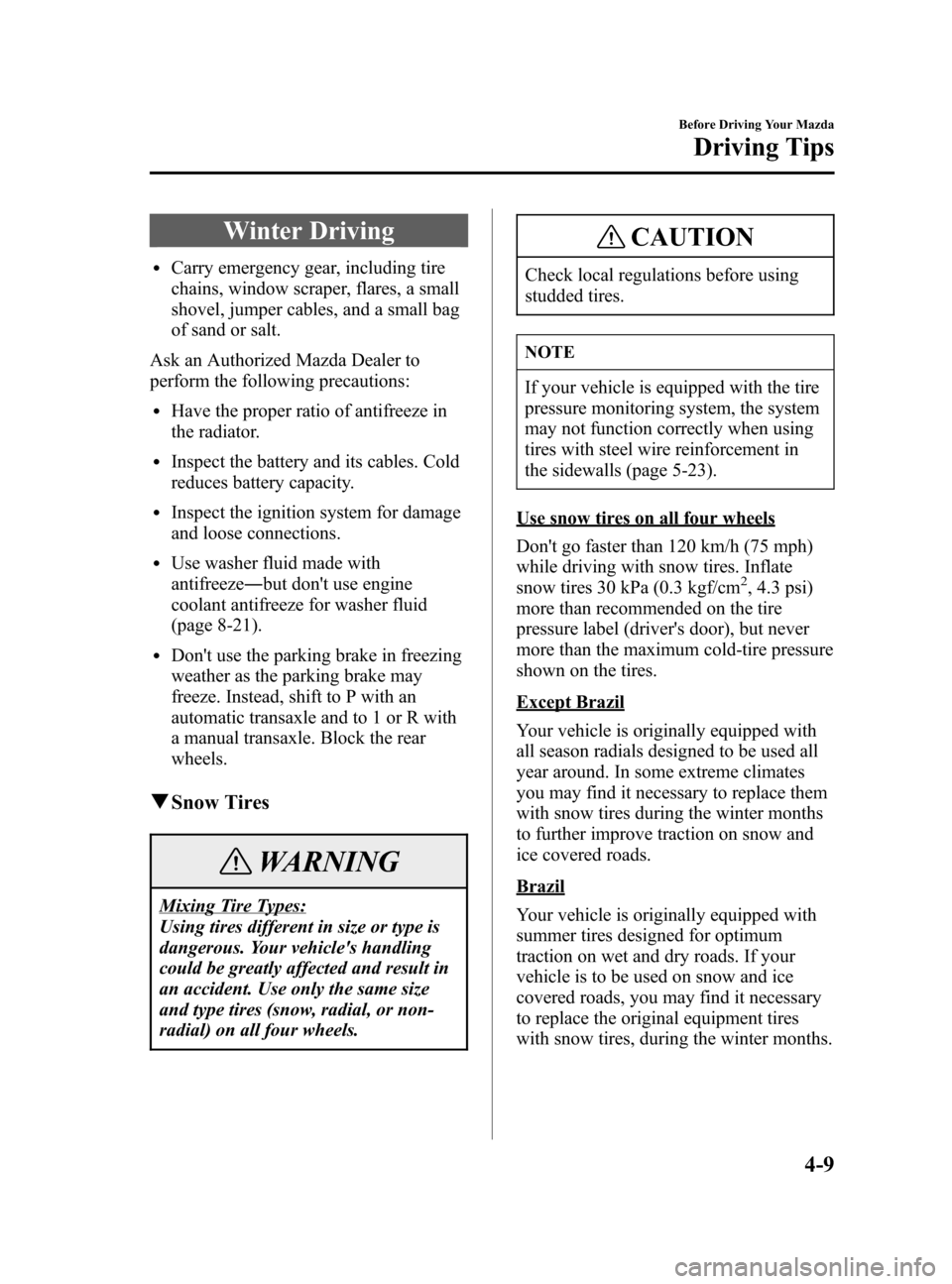
Black plate (107,1)
Winter Driving
lCarry emergency gear, including tire
chains, window scraper, flares, a small
shovel, jumper cables, and a small bag
of sand or salt.
Ask an Authorized Mazda Dealer to
perform the following precautions:
lHave the proper ratio of antifreeze in
the radiator.
lInspect the battery and its cables. Cold
reduces battery capacity.
lInspect the ignition system for damage
and loose connections.
lUse washer fluid made with
antifreeze―but don't use engine
coolant antifreeze for washer fluid
(page 8-21).
lDon't use the parking brake in freezing
weather as the parking brake may
freeze. Instead, shift to P with an
automatic transaxle and to 1 or R with
a manual transaxle. Block the rear
wheels.
qSnow Tires
WARNING
Mixing Tire Types:
Using tires different in size or type is
dangerous. Your vehicle's handling
could be greatly affected and result in
an accident. Use only the same size
and type tires (snow, radial, or non-
radial) on all four wheels.
CAUTION
Check local regulations before using
studded tires.
NOTE
If your vehicle is equipped with the tire
pressure monitoring system, the system
may not function correctly when using
tires with steel wire reinforcement in
the sidewalls (page 5-23).
Use snow tires on all four wheels
Don't go faster than 120 km/h (75 mph)
while driving with snow tires. Inflate
snow tires 30 kPa (0.3 kgf/cm
2, 4.3 psi)
more than recommended on the tire
pressure label (driver's door), but never
more than the maximum cold-tire pressure
shown on the tires.
Except Brazil
Your vehicle is originally equipped with
all season radials designed to be used all
year around. In some extreme climates
you may find it necessary to replace them
with snow tires during the winter months
to further improve traction on snow and
ice covered roads.
Brazil
Your vehicle is originally equipped with
summer tires designed for optimum
traction on wet and dry roads. If your
vehicle is to be used on snow and ice
covered roads, you may find it necessary
to replace the original equipment tires
with snow tires, during the winter months.
Before Driving Your Mazda
Driving Tips
4-9
Mazda3_8T97-EC-04J_Edition1 Page107
Saturday, September 25 2004 2:9 PM
Form No.8T97-EC-04J
Page 135 of 322
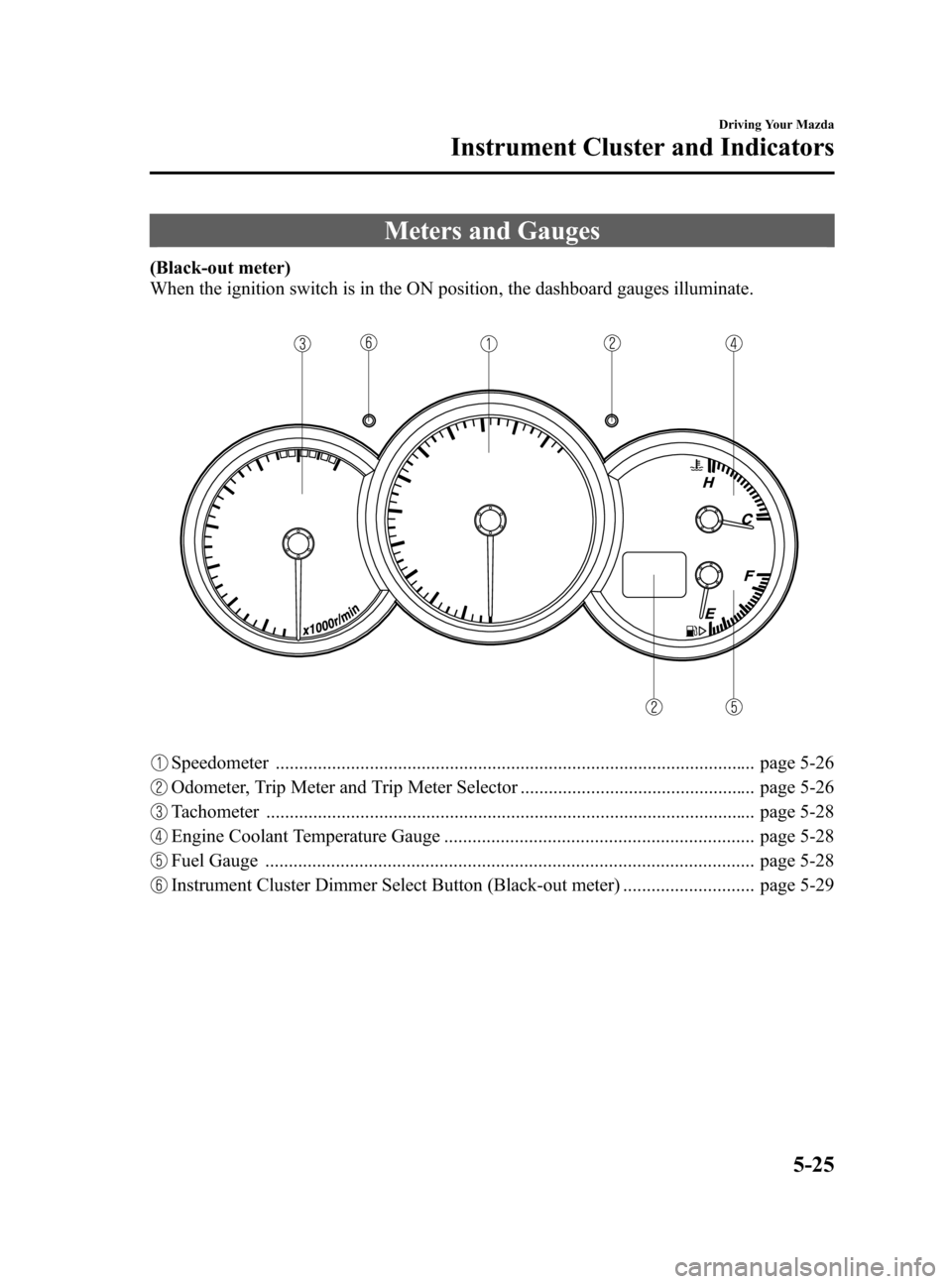
Black plate (135,1)
Meters and Gauges
(Black-out meter)
When the ignition switch is in the ON position, the dashboard gauges illuminate.
Speedometer ...................................................................................................... page 5-26
Odometer, Trip Meter and Trip Meter Selector .................................................. page 5-26
Tachometer ........................................................................................................ page 5-28
Engine Coolant Temperature Gauge .................................................................. page 5-28
Fuel Gauge ........................................................................................................ page 5-28
Instrument Cluster Dimmer Select Button (Black-out meter) ............................ page 5-29
Driving Your Mazda
Instrument Cluster and Indicators
5-25
Mazda3_8T97-EC-04J_Edition1 Page135
Saturday, September 25 2004 2:10 PM
Form No.8T97-EC-04J
Page 138 of 322
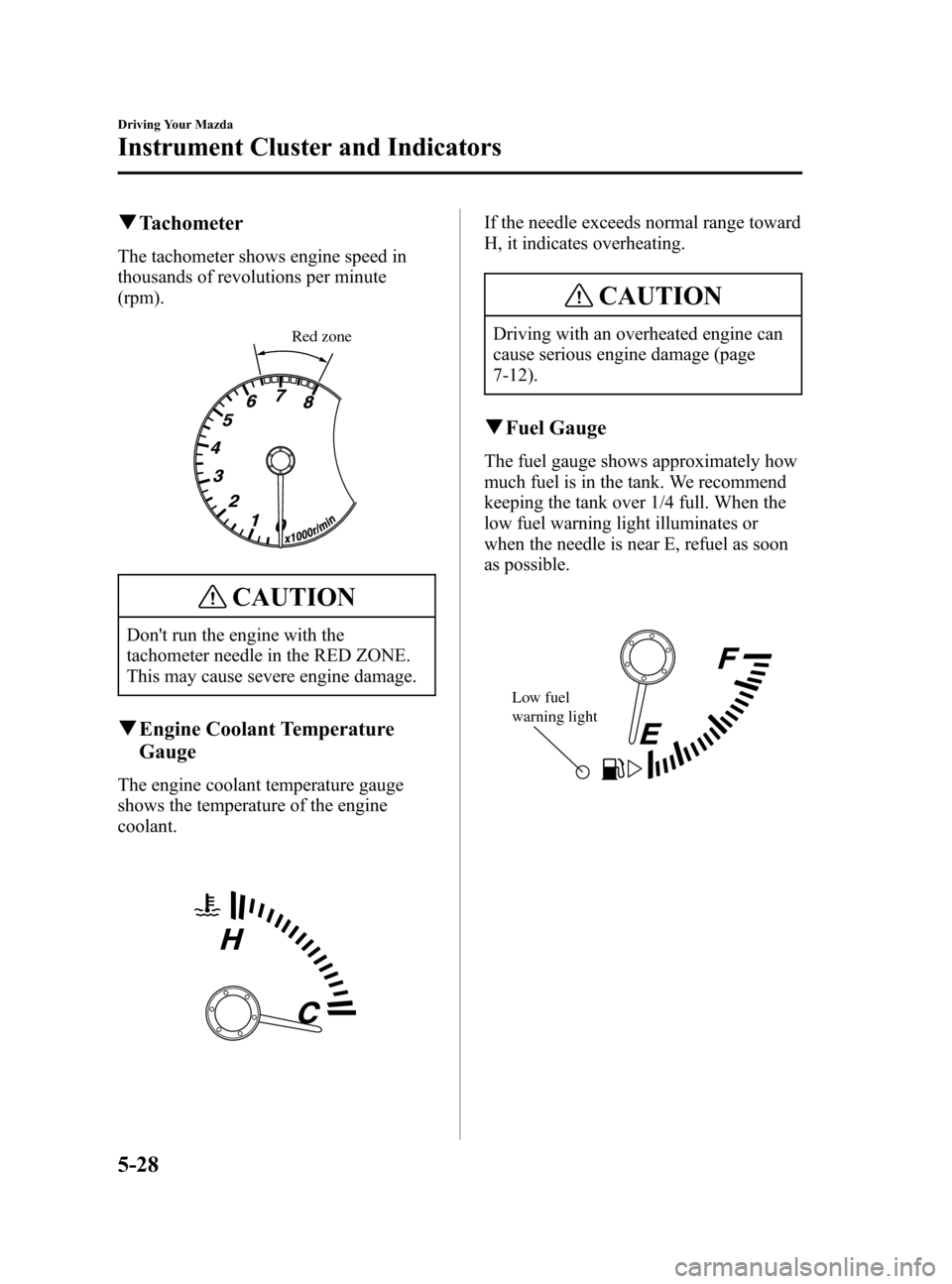
Black plate (138,1)
qTachometer
The tachometer shows engine speed in
thousands of revolutions per minute
(rpm).
Red zone
CAUTION
Don't run the engine with the
tachometer needle in the RED ZONE.
This may cause severe engine damage.
qEngine Coolant Temperature
Gauge
The engine coolant temperature gauge
shows the temperature of the engine
coolant.
If the needle exceeds normal range toward
H, it indicates overheating.
CAUTION
Driving with an overheated engine can
cause serious engine damage (page
7-12).
qFuel Gauge
The fuel gauge shows approximately how
much fuel is in the tank. We recommend
keeping the tank over 1/4 full. When the
low fuel warning light illuminates or
when the needle is near E, refuel as soon
as possible.
Low fuel
warning light
5-28
Driving Your Mazda
Instrument Cluster and Indicators
Mazda3_8T97-EC-04J_Edition1 Page138
Saturday, September 25 2004 2:10 PM
Form No.8T97-EC-04J
Page 220 of 322
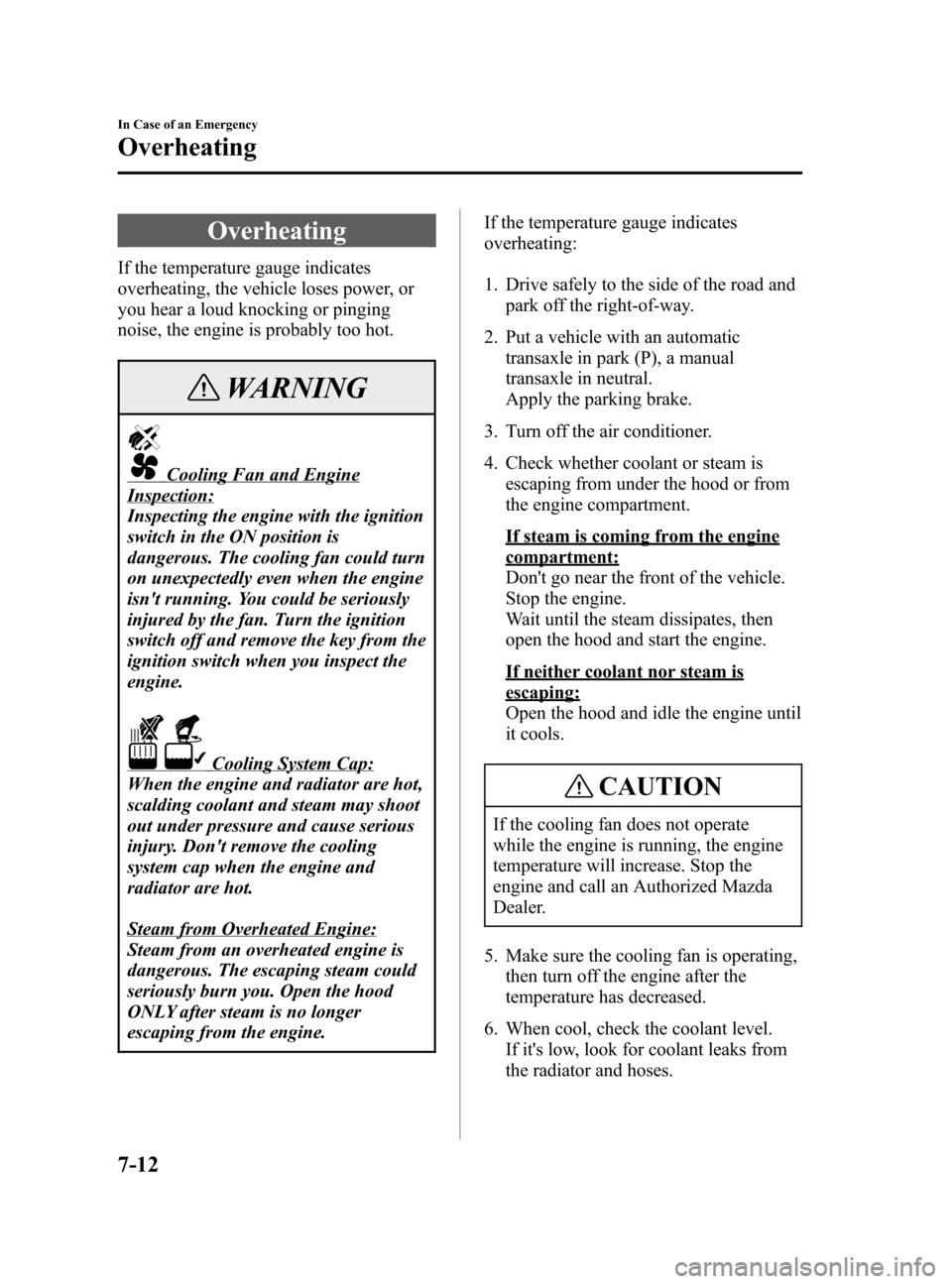
Black plate (220,1)
Overheating
If the temperature gauge indicates
overheating, the vehicle loses power, or
you hear a loud knocking or pinging
noise, the engine is probably too hot.
WARNING
Cooling Fan and Engine
Inspection:
Inspecting the engine with the ignition
switch in the ON position is
dangerous. The cooling fan could turn
on unexpectedly even when the engine
isn't running. You could be seriously
injured by the fan. Turn the ignition
switch off and remove the key from the
ignition switch when you inspect the
engine.
Cooling System Cap:
When the engine and radiator are hot,
scalding coolant and steam may shoot
out under pressure and cause serious
injury. Don't remove the cooling
system cap when the engine and
radiator are hot.
Steam from Overheated Engine:
Steam from an overheated engine is
dangerous. The escaping steam could
seriously burn you. Open the hood
ONLY after steam is no longer
escaping from the engine.If the temperature gauge indicates
overheating:
1. Drive safely to the side of the road and
park off the right-of-way.
2. Put a vehicle with an automatic
transaxle in park (P), a manual
transaxle in neutral.
Apply the parking brake.
3. Turn off the air conditioner.
4. Check whether coolant or steam is
escaping from under the hood or from
the engine compartment.
If steam is coming from the engine
compartment:
Don't go near the front of the vehicle.
Stop the engine.
Wait until the steam dissipates, then
open the hood and start the engine.
If neither coolant nor steam is
escaping:
Open the hood and idle the engine until
it cools.
CAUTION
If the cooling fan does not operate
while the engine is running, the engine
temperature will increase. Stop the
engine and call an Authorized Mazda
Dealer.
5. Make sure the cooling fan is operating,
then turn off the engine after the
temperature has decreased.
6. When cool, check the coolant level.
If it's low, look for coolant leaks from
the radiator and hoses.
7-12
In Case of an Emergency
Overheating
Mazda3_8T97-EC-04J_Edition1 Page220
Saturday, September 25 2004 2:15 PM
Form No.8T97-EC-04J
Page 221 of 322
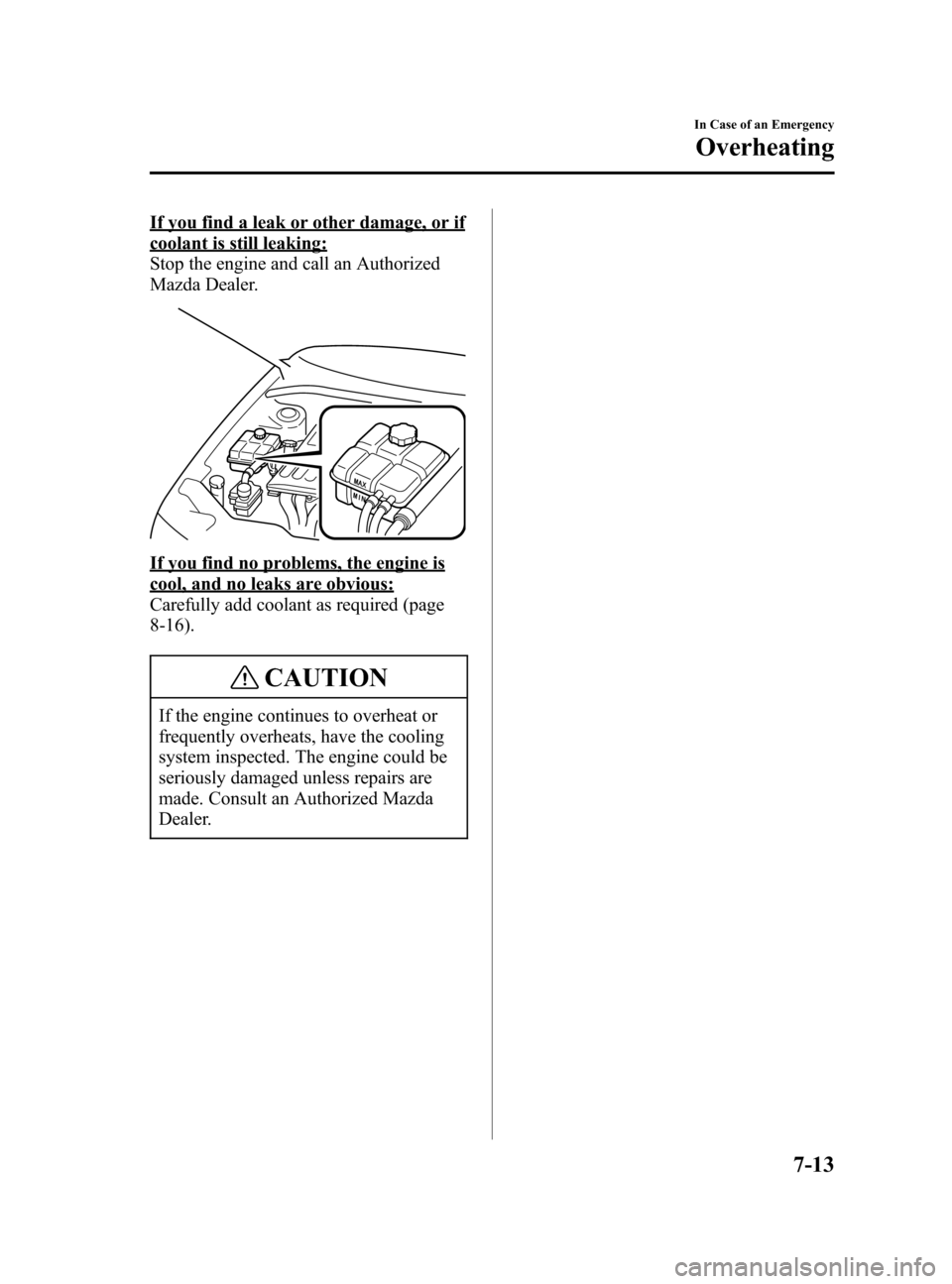
Black plate (221,1)
If you find a leak or other damage, or if
coolant is still leaking:
Stop the engine and call an Authorized
Mazda Dealer.
If you find no problems, the engine is
cool, and no leaks are obvious:
Carefully add coolant as required (page
8-16).
CAUTION
If the engine continues to overheat or
frequently overheats, have the cooling
system inspected. The engine could be
seriously damaged unless repairs are
made. Consult an Authorized Mazda
Dealer.
In Case of an Emergency
Overheating
7-13
Mazda3_8T97-EC-04J_Edition1 Page221
Saturday, September 25 2004 2:15 PM
Form No.8T97-EC-04J
Page 231 of 322
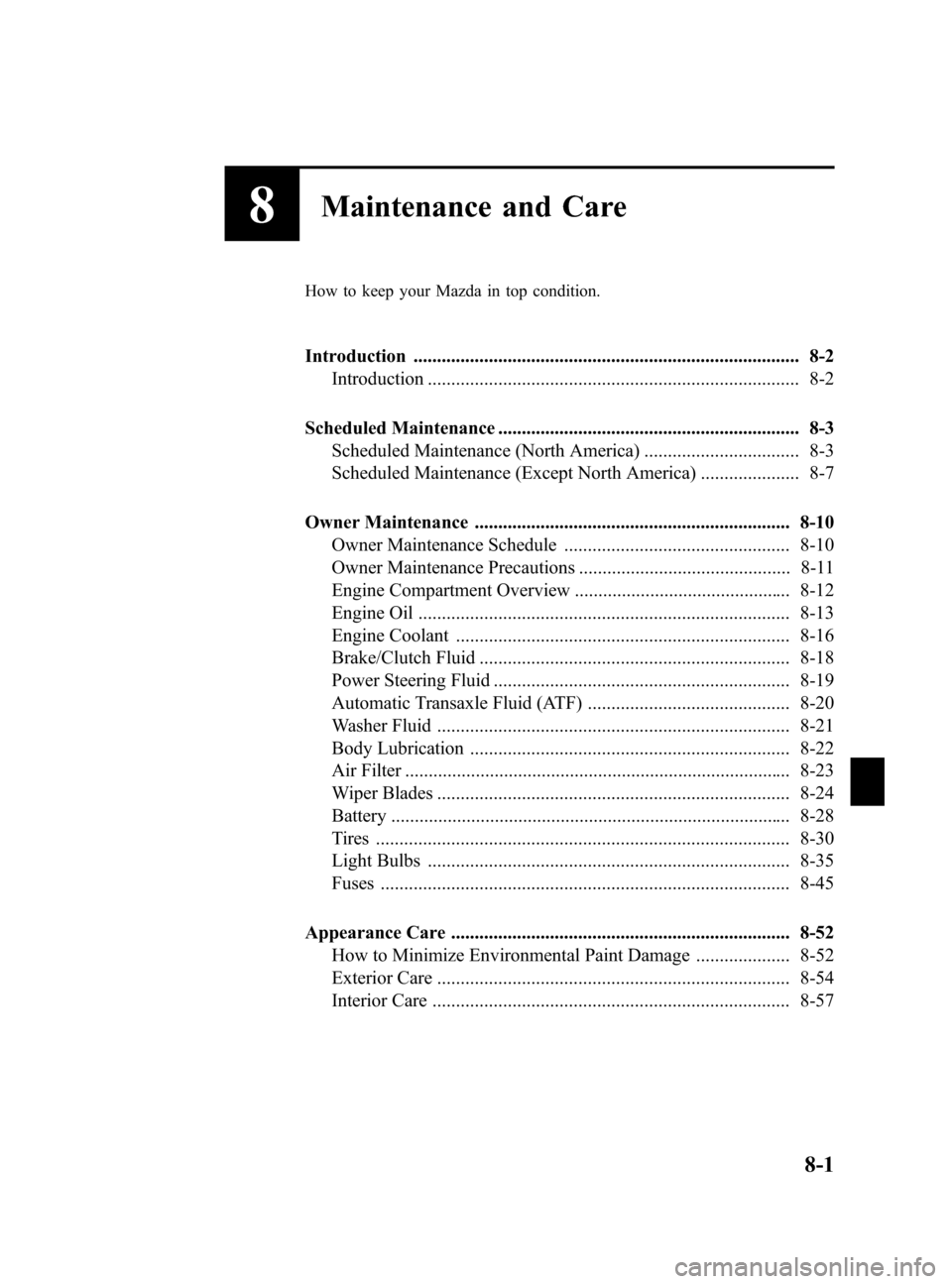
Black plate (231,1)
8Maintenance and Care
How to keep your Mazda in top condition.
Introduction .................................................................................. 8-2
Introduction ............................................................................... 8-2
Scheduled Maintenance ................................................................ 8-3
Scheduled Maintenance (North America) ................................. 8-3
Scheduled Maintenance (Except North America) ..................... 8-7
Owner Maintenance ................................................................... 8-10
Owner Maintenance Schedule ................................................ 8-10
Owner Maintenance Precautions ............................................. 8-11
Engine Compartment Overview .............................................. 8-12
Engine Oil ............................................................................... 8-13
Engine Coolant ....................................................................... 8-16
Brake/Clutch Fluid .................................................................. 8-18
Power Steering Fluid ............................................................... 8-19
Automatic Transaxle Fluid (ATF) ........................................... 8-20
Washer Fluid ........................................................................... 8-21
Body Lubrication .................................................................... 8-22
Air Filter .................................................................................. 8-23
Wiper Blades ........................................................................... 8-24
Battery ..................................................................................... 8-28
Tires ........................................................................................ 8-30
Light Bulbs ............................................................................. 8-35
Fuses ....................................................................................... 8-45
Appearance Care ........................................................................ 8-52
How to Minimize Environmental Paint Damage .................... 8-52
Exterior Care ........................................................................... 8-54
Interior Care ............................................................................ 8-57
8-1
Mazda3_8T97-EC-04J_Edition1 Page231
Saturday, September 25 2004 2:15 PM
Form No.8T97-EC-04J
Page 234 of 322
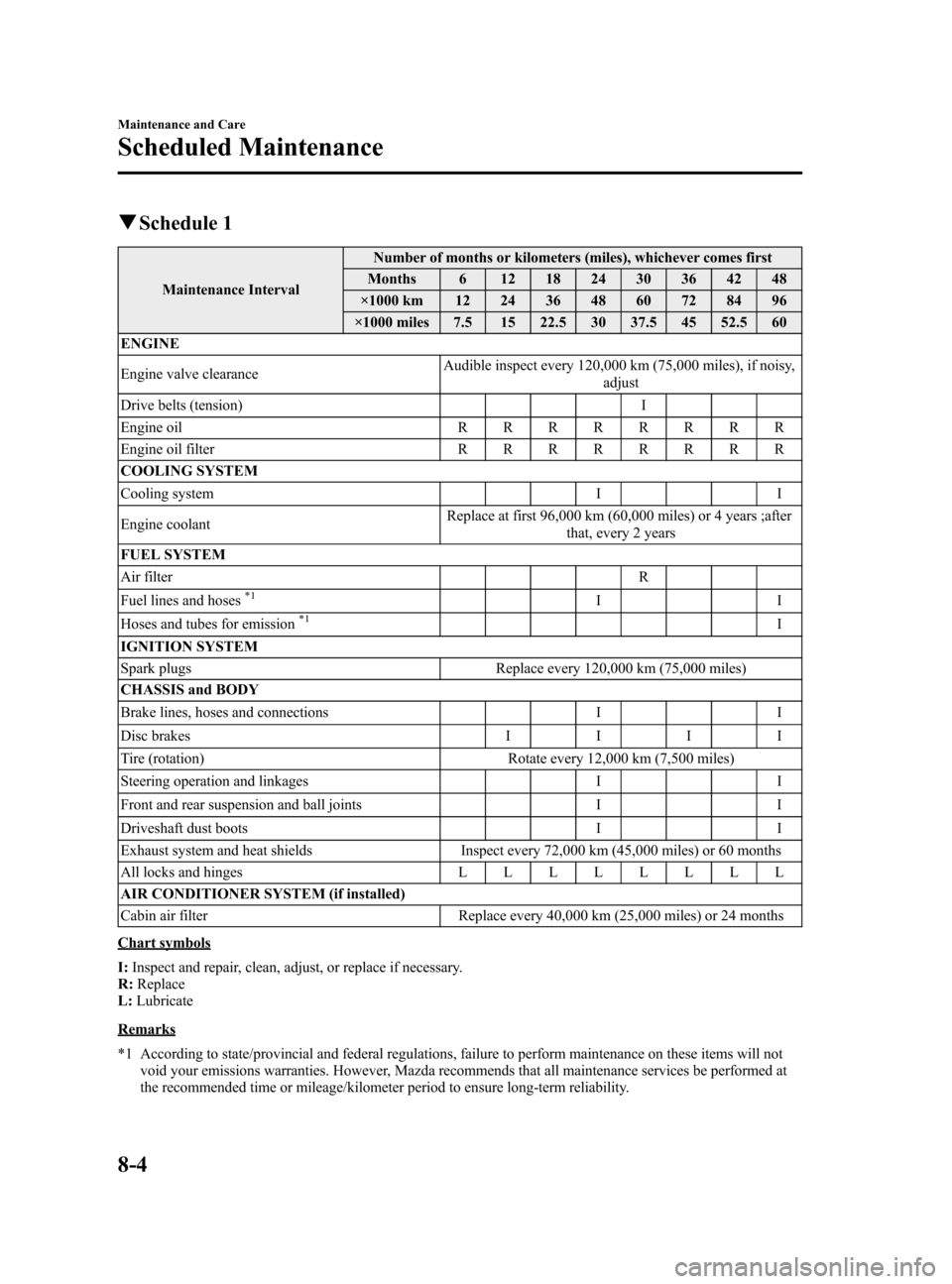
Black plate (234,1)
qSchedule 1
Maintenance IntervalNumber of months or kilometers (miles), whichever comes first
Months 6 12 18 24 30 36 42 48
×1000 km 12 24 36 48 60 72 84 96
×1000 miles 7.5 15 22.5 30 37.5 45 52.5 60
ENGINE
Engine valve clearanceAudible inspect every 120,000 km (75,000 miles), if noisy,
adjust
Drive belts (tension) I
Engine oil R R R R R R R R
Engine oil filter R R R R R R R R
COOLING SYSTEM
Cooling system I I
Engine coolantReplace at first 96,000 km (60,000 miles) or 4 years ;after
that, every 2 years
FUEL SYSTEM
Air filter R
Fuel lines and hoses
*1II
Hoses and tubes for emission*1I
IGNITION SYSTEM
Spark plugs Replace every 120,000 km (75,000 miles)
CHASSIS and BODY
Brake lines, hoses and connections I I
Disc brakes I I I I
Tire (rotation) Rotate every 12,000 km (7,500 miles)
Steering operation and linkages I I
Front and rear suspension and ball joints I I
Driveshaft dust boots I I
Exhaust system and heat shields Inspect every 72,000 km (45,000 miles) or 60 months
All locks and hinges L L L L L L L L
AIR CONDITIONER SYSTEM (if installed)
Cabin air filter Replace every 40,000 km (25,000 miles) or 24 months
Chart symbols
I:Inspect and repair, clean, adjust, or replace if necessary.
R:Replace
L:Lubricate
Remarks
*1 According to state/provincial and federal regulations, failure to perform maintenance on these items will not
void your emissions warranties. However, Mazda recommends that all maintenance services be performed at
the recommended time or mileage/kilometer period to ensure long-term reliability.
8-4
Maintenance and Care
Scheduled Maintenance
Mazda3_8T97-EC-04J_Edition1 Page234
Saturday, September 25 2004 2:15 PM
Form No.8T97-EC-04J
Page 235 of 322
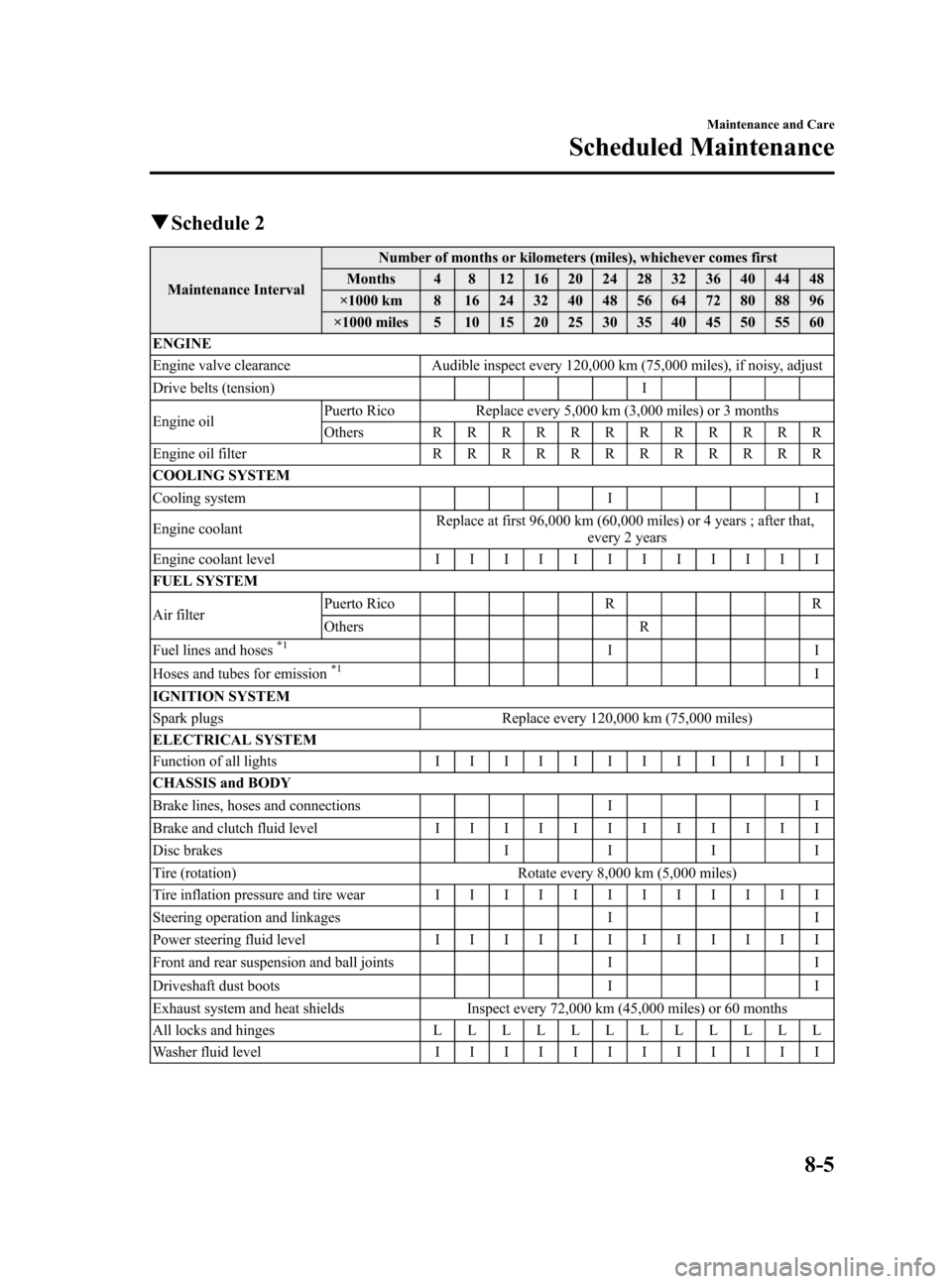
Black plate (235,1)
qSchedule 2
Maintenance IntervalNumber of months or kilometers (miles), whichever comes first
Months 4 8 12 16 20 24 28 32 36 40 44 48
×1000 km 8 16 24 32 40 48 56 64 72 80 88 96
×1000 miles 5 10 15 20 25 30 35 40 45 50 55 60
ENGINE
Engine valve clearance Audible inspect every 120,000 km (75,000 miles), if noisy, adjust
Drive belts (tension) I
Engine oilPuerto Rico Replace every 5,000 km (3,000 miles) or 3 months
Others R R R R R R RRRRRR
Engine oil filter R R R R R R RRRRRR
COOLING SYSTEM
Cooling system I I
Engine coolantReplace at first 96,000 km (60,000 miles) or 4 years ; after that,
every 2 years
Engine coolant level I I I I I I IIIIII
FUEL SYSTEM
Air filterPuerto Rico R R
Others R
Fuel lines and hoses
*1II
Hoses and tubes for emission*1I
IGNITION SYSTEM
Spark plugs Replace every 120,000 km (75,000 miles)
ELECTRICAL SYSTEM
Function of all lights I I I I I I IIIIII
CHASSIS and BODY
Brake lines, hoses and connections I I
Brake and clutch fluid level I I I I I I IIIIII
Disc brakesIIII
Tire (rotation) Rotate every 8,000 km (5,000 miles)
Tire inflation pressure and tire wear I I I I I I IIIIII
Steering operation and linkages I I
Power steering fluid level I I I I I I IIIIII
Front and rear suspension and ball joints I I
Driveshaft dust boots I I
Exhaust system and heat shields Inspect every 72,000 km (45,000 miles) or 60 months
All locks and hinges L L L L L LLLLLLL
Washer fluid level I I I I I I IIIIII
Maintenance and Care
Scheduled Maintenance
8-5
Mazda3_8T97-EC-04J_Edition1 Page235
Saturday, September 25 2004 2:15 PM
Form No.8T97-EC-04J
Page 238 of 322
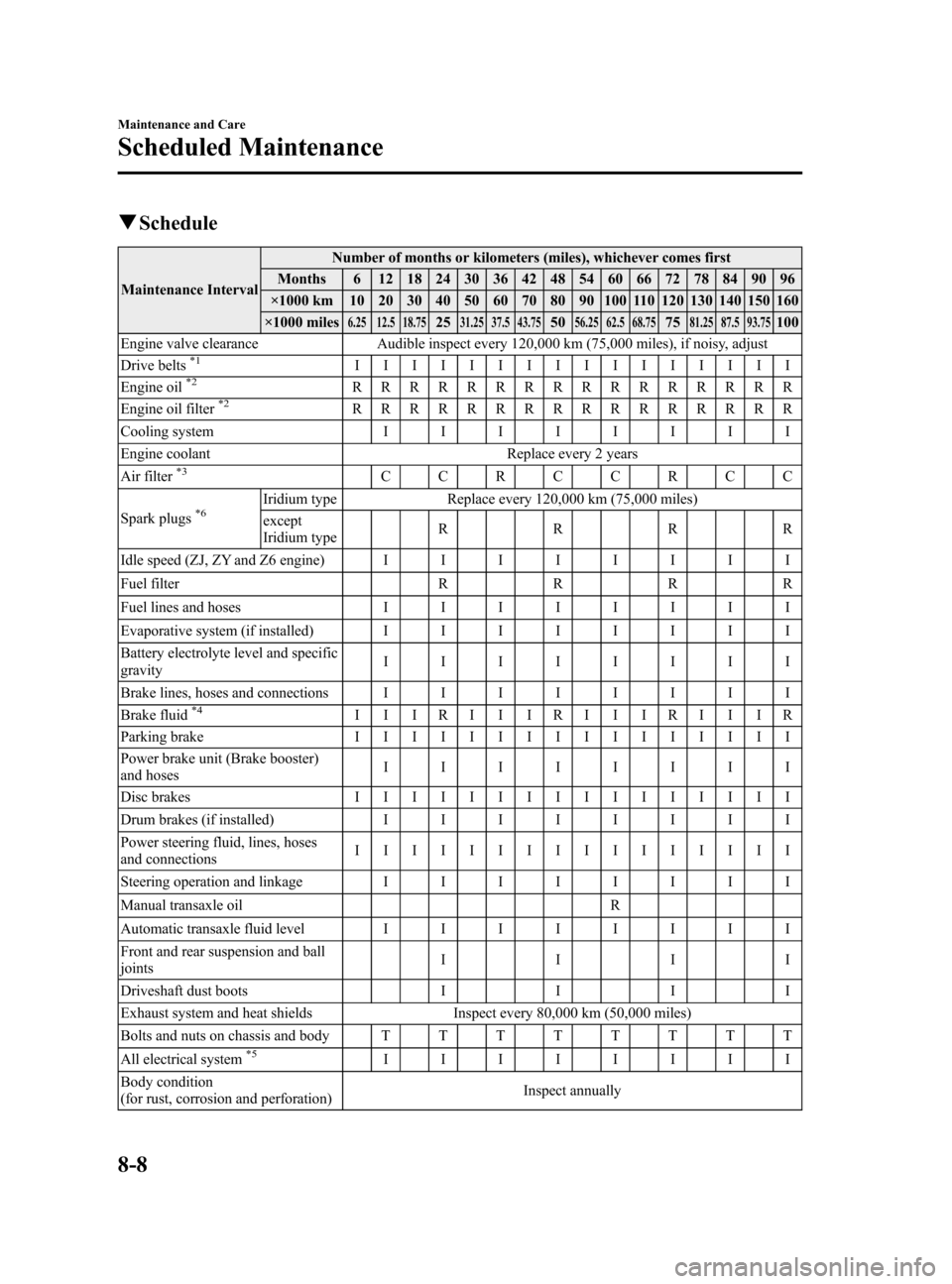
Black plate (238,1)
qSchedule
Maintenance IntervalNumber of months or kilometers (miles), whichever comes first
Months 6 12 18 24 30 36 42 48 54 60 66 72 78 84 90 96
×1000 km 10 20 30 40 50 60 70 80 90 100 110 120 130 140 150 160
×1000 miles
6.25 12.5 18.752531.25 37.5 43.755056.25 62.5 68.757581.25 87.5 93.75100
Engine valve clearance Audible inspect every 120,000 km (75,000 miles), if noisy, adjust
Drive belts
*1IIIIIIIIIIIIIIII
Engine oil*2RRRRRRRRRRRRRRRR
Engine oil filter*2RRRRRRRRRRRRRRRR
Cooling system I I I I I I I I
Engine coolant Replace every 2 years
Air filter
*3CCRCCRCC
Spark plugs
*6Iridium type Replace every 120,000 km (75,000 miles)
except
Iridium typeRRRR
Idle speed (ZJ, ZY and Z6 engine) I I I I I I I I
Fuel filterRRRR
Fuel lines and hoses I I I I I I I I
Evaporative system (if installed) I I I I I I I I
Battery electrolyte level and specific
gravityIIIIIIII
Brake lines, hoses and connections I I I I I I I I
Brake fluid
*4IIIRIIIRIIIRIIIR
Parking brake I I IIIIIIIIIIIIII
Power brake unit (Brake booster)
and hosesIIIIIIII
Disc brakes I I IIIIIIIIIIIIII
Drum brakes (if installed) I I I I I I I I
Power steering fluid, lines, hoses
and connectionsIIIIIIIIIIIIIIII
Steering operation and linkage I I I I I I I I
Manual transaxle oil R
Automatic transaxle fluid level I I I I I I I I
Front and rear suspension and ball
jointsIIII
Driveshaft dust bootsIIII
Exhaust system and heat shields Inspect every 80,000 km (50,000 miles)
Bolts and nuts on chassis and body T T T T T T T T
All electrical system
*5IIIIIIII
Body condition
(for rust, corrosion and perforation)Inspect annually
8-8
Maintenance and Care
Scheduled Maintenance
Mazda3_8T97-EC-04J_Edition1 Page238
Saturday, September 25 2004 2:16 PM
Form No.8T97-EC-04J